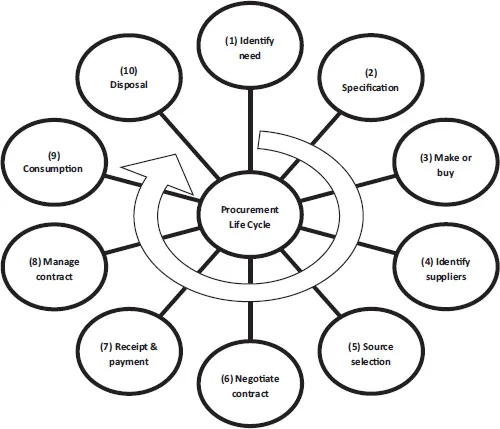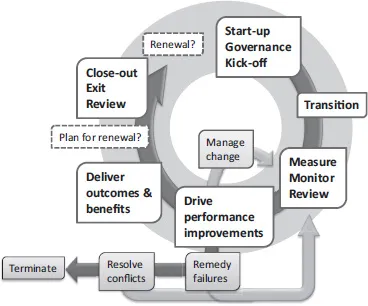
- 186 pages
- English
- ePUB (mobile friendly)
- Available on iOS & Android
The Procurement Models Handbook
About this book
Building from the previous two successful editions, The Procurement Models Handbook is an essential resource for everyone working in the procurement profession, including those selling directly to it. The authors provide the reader with a useful guide to the business models most frequently applied in the procurement and supply chain arena.
Procurement and supply chain management are two of the highest contributors to corporate success in the modern world. This third edition is a new revised international version with additional tools that reflect the value of procurement in our globally-connected world. The authors have included over 50 well-established strategic and operational models that have a proven track record of delivering value over years of practice. Each model is presented pictorially, with explanatory commentary on its practical application to support.
These models are designed to save unnecessary cost and deliver significant benefits for their user and have been carefully selected by the authors based on their originality and usefulness for practical application in the context of procurement and the supply chain. The Procurement Models Handbook is an invaluable and enduring source of reference for practitioners and business managers, as well as an essential learning support for business and procurement students.
Frequently asked questions
- Essential is ideal for learners and professionals who enjoy exploring a wide range of subjects. Access the Essential Library with 800,000+ trusted titles and best-sellers across business, personal growth, and the humanities. Includes unlimited reading time and Standard Read Aloud voice.
- Complete: Perfect for advanced learners and researchers needing full, unrestricted access. Unlock 1.4M+ books across hundreds of subjects, including academic and specialized titles. The Complete Plan also includes advanced features like Premium Read Aloud and Research Assistant.
Please note we cannot support devices running on iOS 13 and Android 7 or earlier. Learn more about using the app.
Information
Section 1
Key processes
Model 1
Procurement life cycle

Overview
Elements
- Stage 1 – Identify need. The life cycle is initiated with the identification of a need. The business has a requirement and a purchase is required to fulfil it.
- Stage 2 – Specification. This is the documented statement of requirements. It is then used by suppliers to assist with technical and pricing decisions.
- Stage 3 – Make or buy? The ‘make’ decision involves the organisation proceeding to fulfil the need internally, whereas the ‘buy’ decision requires the organisation to purchase from a third party.
- Stage 4 – Identify suppliers. This stage involves searching and analysing the supply market; it is about identifying suitable and appropriate resources.
- Stage 5 – Source selection. This involves identifying the preferred supplier to supply the goods or services required, possibly through a tendering or RFx exercise.
- Stage 6 – Negotiate contract. Once a supplier has been selected there may need to be several rounds of negotiation or clarification in order to agree the final commercial and contractual details.
- Stage 7 – Receipt and payment. Payment for goods and services usually occurs after receipt, although this is not always the case. This is often referred to as ‘purchasing’ or even ‘purchase-to-pay’ (P2P).
- Stage 8 – Manage contract. The contract needs to be managed in order to ensure performance by the supplier. This stage is also sometimes referred to as supply management.
- Stage 9 – Consumption. The bought-in goods and serviced are utilised during the life of the contract and may need replenishment, maintenance or some form of service management.
- Stage 10 – Decommission and disposal. The end of the life cycle involves the disposal of the product. This is important in view of the drivers for sustainability and whole life costs.
So what?
Procurement application
- Identifies the key stages in the procurement process
- Supports business process re-engineering
- Aids the procurement planning process.
Limitations
Further reading
Associated models
- Contract Management Cycle (Model 2)
- Category Management Process (Model 3)
- Outsourcing Decision Matrix (Model 26)
- The Negotiation Process (Model 32).
Model 2
Contract management cycle

Overview
Elements
| Start-up Governance Kick-off | The initial stages immediately following contract award: • Roles and responsibilities established • Contract Management Plan established • Kick-off meeting held • Pre-commencement requirements fulfilled. |
| Transition | This represents the mobilisation and ramp-up of activities to full delivery: • Handover completed • Mobilisation of resources • Ramp-up of demand/supply to maturity. |
| Measure Monitor Review | Throughout the maturity of the contract, the emphasis is upon performance delivery: • Measuring key performance criteria • Monitoring performance data • Reviewing and interpreting performance • Mitigating risks. |
| Drive performance improvements | Delivering the required contract performance throughout the life of the contract: • Delivering the required benefits • Compliant with requirements • Continuous improvement gains • Customer satisfaction. Within this the sub-phases of managing change and remedying failures are included. |
| Deliver outcomes and benefits | Realising the commercial and operational benefits [outcomes] specified within the contract: • Desired outcomes and deliverables • Commercial gains • Social, economic and environmental performance • Ratification of the contract delivery. |
| Close-out Exit Review | Preparing for the end of the contract: • Preparing for and managing the exit • Fulfilling termination requirements • Handover to replacement supplier(s) • Learning review for future improvements. This also include the sub-phases of planning for and executing any contract renewals beyond the initial contract term. |
So what?
Procurement application
- Defines key activities for contract managers
- Helps to manage contract deliverables and performance
- Mitigates contractual and commercial risk.
Limitations
Further reading
Associated models
- Procurement Life Cycle (Model 1)
- Plan–Do–Check–Act Cycle (Model 5)
- Risk Assessment (...
Table of contents
- Cover
- Half Title
- Title
- Copyright
- Contents
- List of figures
- Acknowledgements
- About the authors
- Introduction
- SECTION 1 Key processes
- SECTION 2 Strategic analysis
- SECTION 3 Relationships
- SECTION 4 Negotiation
- SECTION 5 Management
- SECTION 6 Organisation
- Bibliography and suggested further reading
- Index